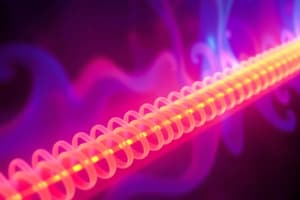Podcast
Questions and Answers
Which of the following scenarios primarily demonstrates heat transfer through convection?
Which of the following scenarios primarily demonstrates heat transfer through convection?
- Heat felt through a glass window on a sunny day
- A radiator heating a room. (correct)
- A metal spoon heating up when placed in a hot cup of coffee.
- Sunlight warming the Earth's surface.
A material with high emissivity will radiate heat poorly.
A material with high emissivity will radiate heat poorly.
False (B)
According to Fourier's Law, what is the relationship between heat transfer rate and material thickness, assuming all other variables are constant?
According to Fourier's Law, what is the relationship between heat transfer rate and material thickness, assuming all other variables are constant?
inversely proportional
The transfer of heat through electromagnetic waves is known as ______.
The transfer of heat through electromagnetic waves is known as ______.
Match the following materials with their typical thermal conductivity properties:
Match the following materials with their typical thermal conductivity properties:
Which factor does NOT directly affect the rate of heat transfer by convection?
Which factor does NOT directly affect the rate of heat transfer by convection?
Forced convection relies on density differences created by temperature gradients, while natural convection involves using fans or pumps to move fluid.
Forced convection relies on density differences created by temperature gradients, while natural convection involves using fans or pumps to move fluid.
What is a 'black body' in the context of thermal radiation?
What is a 'black body' in the context of thermal radiation?
According to the Stefan-Boltzmann Law, the radiated heat power is proportional to the fourth power of the absolute ______.
According to the Stefan-Boltzmann Law, the radiated heat power is proportional to the fourth power of the absolute ______.
Which of the following materials would be the WORST choice for a cooking pot if you want it to heat food quickly and evenly?
Which of the following materials would be the WORST choice for a cooking pot if you want it to heat food quickly and evenly?
Flashcards
Thermal Physics
Thermal Physics
The study of energy, heat, and macroscopic behavior of matter.
Heat Transfer
Heat Transfer
Transfer of thermal energy from a hot object to a cooler one.
Conduction
Conduction
Heat transfer through a material without the material moving.
Convection
Convection
Signup and view all the flashcards
Radiation
Radiation
Signup and view all the flashcards
Emissivity (ε)
Emissivity (ε)
Signup and view all the flashcards
Good Emitters
Good Emitters
Signup and view all the flashcards
Bad Emitters
Bad Emitters
Signup and view all the flashcards
Temperature Difference
Temperature Difference
Signup and view all the flashcards
Surface Area
Surface Area
Signup and view all the flashcards
Study Notes
- Thermal physics is the study of energy, heat, and the macroscopic behavior of matter
Heat Transfer Mechanisms
- Heat transfer refers to the process of thermal energy moving from a hot object to a cooler one
- Three primary heat transfer mechanisms include conduction, convection, and radiation
Conduction
- Conduction is the transfer of heat through a material, without any motion of the material itself
- Occurs when there is a temperature gradient within a body
- Heat flows from the region of higher temperature to the region of lower temperature
- Effective in solids where molecules are in close contact
- The rate of heat conduction depends on the material's thermal conductivity (k), area (A), temperature difference (ΔT), and thickness (d)
- Described by Fourier's Law: Q = -kA(ΔT/d)
- Good thermal conductors have high k values (e.g. metals)
- Thermal insulators have low k values (e.g. wood, plastic)
Convection
- Convection is the transfer of heat by the movement of a fluid (liquid or gas)
- Occurs when a fluid is heated, becomes less dense, and rises, while cooler fluid sinks to take its place
- Results in a circulating current that transfers heat
- Natural convection relies on density differences due to temperature gradients
- Forced convection involves the use of a fan or pump to move the fluid, enhancing heat transfer
- Convection heat transfer depends on the fluid's properties, flow velocity, and the geometry of the heat transfer surface
- Described by Newton's Law of Cooling: Q = hA(Ts - Tf)
- h stands for the convection heat transfer coefficient
- A stands for the surface area
- Ts stands for the surface temperature
- Tf stands for the fluid temperature
Radiation
- Radiation involves the transfer of heat through electromagnetic waves
- Does not require a medium and can occur in a vacuum
- All objects emit thermal radiation, with the amount and spectrum of radiation depending on their temperature
- The rate of heat radiation is described by the Stefan-Boltzmann Law: Q = εσAT⁴
- Q stands for the radiated heat power
- ε stands for the emissivity of the object
- σ is the Stefan-Boltzmann constant (5.67 x 10⁻⁸ W/m²K⁴)
- A stands for the surface area
- T stands for the absolute temperature in Kelvin
Emissivity
- Emissivity (ε) measures how effectively a surface emits thermal radiation, compared to a black body
- Ranges from 0 (for a perfect reflector) to 1 (for a perfect black body)
- A black body is a theoretical object that absorbs all incident electromagnetic radiation and emits the maximum possible radiation at a given temperature
Good Emitters and Bad Emitters
- Good emitters are materials with high emissivity (close to 1)
- They efficiently radiate heat
- Examples include dark and rough surfaces
- Bad emitters are materials with low emissivity (close to 0)
- They reflect radiation and emit heat poorly
- Examples include shiny and smooth surfaces, such as polished metals
Factors Affecting Heat Transfer
- Temperature difference: Larger temperature differences result in greater heat transfer rates for all three mechanisms
- Surface area: Increasing the surface area in contact with an object enhances both convection and radiation
- Material properties: Thermal conductivity, specific heat capacity, density, and emissivity of materials impact heat transfer rates
Applications
- Conduction is important in cooking, heating, and cooling systems; in cooking, heat is conducted through the pot to cook food
- Convection is used in radiators, ovens, and air conditioning
- Radiation is relevant in solar heating, infrared imaging, and microwave ovens
Studying That Suits You
Use AI to generate personalized quizzes and flashcards to suit your learning preferences.




